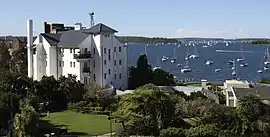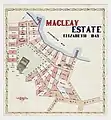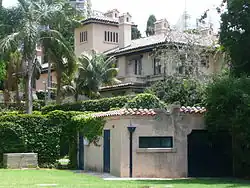| Elizabeth Bay Sydney, New South Wales | |||||||||||||||
|---|---|---|---|---|---|---|---|---|---|---|---|---|---|---|---|
 View from Elizabeth Bay House | |||||||||||||||
| Population | 4,878 (SAL 2021)[1] | ||||||||||||||
| • Density | 16,493.3/km2 (42,717/sq mi) | ||||||||||||||
| Postcode(s) | 2011 | ||||||||||||||
| Elevation | 50 m (164 ft) | ||||||||||||||
| Area | 0.3 km2 (0.1 sq mi) | ||||||||||||||
| Location | 2 km (1 mi) E of Sydney CBD | ||||||||||||||
| LGA(s) | City of Sydney | ||||||||||||||
| State electorate(s) | Sydney | ||||||||||||||
| Federal division(s) | Wentworth | ||||||||||||||
| |||||||||||||||
Elizabeth Bay is a harbourside inner city suburb in the Eastern suburbs of Sydney, in the state of New South Wales, Australia. Elizabeth Bay is located three kilometres east of the Sydney central business district and is part of the local government area of the City of Sydney.
The suburb of Elizabeth Bay takes its name from the bay on Sydney Harbour. Macleay Point separates Elizabeth Bay from Rushcutters Bay. The suburb of Elizabeth Bay is surrounded by the suburbs of Rushcutters Bay and Potts Point. Kings Cross is a locality on the south-western border and Garden Island is a locality, to the north.
History
Elizabeth Bay was named in honour of Governor Lachlan Macquarie's wife, Elizabeth.
Elizabeth Bay is one of the places around Sydney Harbour that has been officially gazetted as a dual named site by the Geographical Names Board (GNB). The official dual name for this place is 'Elizabeth Bay / Gurrajin'. Nearby officially assigned dual names are 'Elizabeth Point / Jerrowan' and 'Macleay Point / Yurrandubbee'.[2][3] The GNB dual naming policy applies to already named geographical features or cultural sites. Dual naming means that the original Aboriginal place name has been officially reassigned by the Geographical Names Board, and is recognised along with its more recent European place name.[4]
An earlier source claims this area was originally known by the Aboriginal name 'Yarrandabby' and what is now Macleay Point was 'Jerrewon'.[5]
Alexander Macleay (1767–1848), the Colonial Secretary of New South Wales, was granted 22 hectares (54 acres) here in 1828. He commissioned architect John Verge (1788–1861) to build Elizabeth Bay House, a Regency style home that was completed in 1837.
Early Subdivision Plans
 Macleay Estate - Elizabeth Bay - Elizabeth Bay, Macley St, Ithaca Rd, Onslow Lane
Macleay Estate - Elizabeth Bay - Elizabeth Bay, Macley St, Ithaca Rd, Onslow Lane Macleay's Estate - Elizabeth Bay - Onslow Ln, Billyard Ln, Ithaca Rd, Macleay St, Elizabeth Bay Rd, 1882
Macleay's Estate - Elizabeth Bay - Onslow Ln, Billyard Ln, Ithaca Rd, Macleay St, Elizabeth Bay Rd, 1882 Elizabeth Bay - Elizabeth Bay Rd, Rushcutters Bay Rd, 1886
Elizabeth Bay - Elizabeth Bay Rd, Rushcutters Bay Rd, 1886 Elizabeth Bay - Birtley Estate - Elizabeth Bay Rd, Birtley Pl, 1927
Elizabeth Bay - Birtley Estate - Elizabeth Bay Rd, Birtley Pl, 1927 Water Frontages- Elizabeth Bay - Rockley House & Grounds - Elizabeth Bay Rd, 1927
Water Frontages- Elizabeth Bay - Rockley House & Grounds - Elizabeth Bay Rd, 1927 Elizabeth Bay House Estate - Billyard Ave, Wylde St, Onslow Ave, Victoria St, Woolcott St, Darlinghurst Rd, 1934
Elizabeth Bay House Estate - Billyard Ave, Wylde St, Onslow Ave, Victoria St, Woolcott St, Darlinghurst Rd, 1934
Heritage listings

Elizabeth Bay has many heritage-listed sites, including the following listed on the New South Wales State Heritage Register:
- 18–18a Billyard Avenue: Edgerley[6]
- 42 Billyard Avenue: Boomerang[7]
- 97 Elizabeth Bay Road: Tresco[8]
- 102 Elizabeth Bay Road: Ashton[9]
- 7 Onslow Avenue and 14–16 (the northern boundary of) Onslow Avenue: Elizabeth Bay House[10][11]
Ashton
Ashton, located at the bottom of Elizabeth Bay Road, was designed by Thomas Rowe in the Victorian Italianate style and built c. 1875. It was originally part of a group of villas built for well-off clients who included Thomas Rowe, John Grafton Ross, Charles Henry Hoskins and Sir Cecil Harold Hoskins. In more recent years, the character of the area was changed radically by the building of blocks of flats, but Ashton survived as one of the few original buildings in the area.[9]
Boomerang
Boomerang is perhaps the best surviving suburban estate of its period on the harbour foreshores. It was designed by Neville Hampson in 1926 for Frank Albert, a music publisher. This Hollywood Spanish Mission style dwelling and flats are of stuccoed brick with vaguely classical windows and decoration, under a terracotta hipped roof. The exterior colour is dull brown. The interior maintains the theatrical air with rooms decorated in different styles from various historical eras. The gardens, which have significantly matured, are an amalgamation of palm trees, shrubs and fountains with tennis court and boathouse.[7] A private residence, it sold for A$20.7 million in 2005 to Lindsay Fox. It has been used as a backdrop for Hollywood films, including Mission: Impossible 2, and is heritage-listed.[12]
Elizabeth Bay House
Elizabeth Bay House is a historic house managed by the Historic Houses Trust, located in Onslow Avenue with views across Sydney Harbour. It was designed by John Verge in the Regency style[10] and is listed on the (now defunct) Register of the National Estate.[12] The adjacent grotto is also listed on New South Wales Heritage Register.[11]
Tresco
Across the road from Ashton is Tresco, a two-storey home designed by Thomas Rowe and built in 1868. It was constructed by Italian stonemasons who were brought to Australia by the Joubert brothers, who were prominent in the early settlement of Hunters Hill. In 1913 it became the official residence of the Flag Officer in Charge, Royal Australian Navy, Eastern Australia.[8][12]
Population
According to the 2021 census, there were 4,878 living in Elizabeth Bay.[13]
At the 2016 census, there were 5,215 residents in Elizabeth Bay. 51.9% of people were born in Australia, with the top other countries of birth being England (6.1%), New Zealand (4.0%), United States of America (2.0%), Italy (1.6%), and France (1.6%). 69.6% of people only spoke English at home. Other languages spoken at home included French (2.5%) and Spanish (2.4%). The most common responses for religion were No Religion (43.9%) and Catholic (18.0%). The majority of dwellings in Elizabeth Bay were units or apartments (98.6%) and there were only 12 separate houses in the suburb. 60.3% of residents were renting their home and only 19.9% owned their home outright. The median weekly household income was $1,989 compared to the national median of $1,438.[14]
In 2011, 31.5% of residents traveled to work by public transport, 25.3% walked to work, and 22.5% travelled by car.[15]
References
- ↑ Australian Bureau of Statistics (28 June 2022). "Elizabeth Bay (suburb and locality)". Australian Census 2021 QuickStats. Retrieved 28 June 2022.
- ↑ Troy, Jakelin; Walsh, Michael (2009). "Reinstating Aboriginal placenames around Port Jackson and Botany Bay". In Koch, Harold; Hercus, Luise (eds.). Aboriginal placenames: naming and re-naming the Australian landscape. Canberra: ANU E-Press. ISBN 9781921666094.
- ↑ "Sydney Barani website". Archived from the original on 17 November 2015. Retrieved 10 July 2021.
- ↑ "Geographical Names Board". Archived from the original on 14 December 2019. Retrieved 10 July 2021.
- ↑ The Book of Sydney Suburbs, Compiled by Frances Pollon, Angus & Robertson Publishers, 1990, Published in Australia ISBN 0-207-14495-8, page 95
- ↑ "Edgerley". New South Wales State Heritage Register. Department of Planning & Environment. H00671. Retrieved 18 May 2018.
 Text is licensed by State of New South Wales (Department of Planning and Environment) under CC-BY 4.0 licence.
Text is licensed by State of New South Wales (Department of Planning and Environment) under CC-BY 4.0 licence. - 1 2 "Boomerang". New South Wales State Heritage Register. Department of Planning & Environment. H00038. Retrieved 18 May 2018.
 Text is licensed by State of New South Wales (Department of Planning and Environment) under CC-BY 4.0 licence.
Text is licensed by State of New South Wales (Department of Planning and Environment) under CC-BY 4.0 licence. - 1 2 "Tresco, grounds and trees". New South Wales State Heritage Register. Department of Planning & Environment. H00780. Retrieved 18 May 2018.
 Text is licensed by State of New South Wales (Department of Planning and Environment) under CC-BY 4.0 licence.
Text is licensed by State of New South Wales (Department of Planning and Environment) under CC-BY 4.0 licence. - 1 2 "Ashton and its grounds". New South Wales State Heritage Register. Department of Planning & Environment. H01684. Retrieved 18 May 2018.
 Text is licensed by State of New South Wales (Department of Planning and Environment) under CC-BY 4.0 licence.
Text is licensed by State of New South Wales (Department of Planning and Environment) under CC-BY 4.0 licence. - 1 2 "Elizabeth Bay House". New South Wales State Heritage Register. Department of Planning & Environment. H00006. Retrieved 18 May 2018.
 Text is licensed by State of New South Wales (Department of Planning and Environment) under CC-BY 4.0 licence.
Text is licensed by State of New South Wales (Department of Planning and Environment) under CC-BY 4.0 licence. - 1 2 "Elizabeth Bay House Grotto Site and works". New South Wales State Heritage Register. Department of Planning & Environment. H00116. Retrieved 18 May 2018.
 Text is licensed by State of New South Wales (Department of Planning and Environment) under CC-BY 4.0 licence.
Text is licensed by State of New South Wales (Department of Planning and Environment) under CC-BY 4.0 licence. - 1 2 3 The Heritage of Australia, p.2/81. ISBN 0-333-33750-6.
- ↑ "2021 Elizabeth Bay, Census All persons QuickStats". Australian Bureau of Statistics. Retrieved 19 August 2022.
- ↑ Australian Bureau of Statistics (27 June 2017). "Elizabeth Bay (State Suburb)". 2016 Census QuickStats. Retrieved 2 July 2017.
- ↑ Australian Bureau of Statistics (31 October 2012). "Elizabeth Bay (State Suburb)". 2011 Census QuickStats. Retrieved 24 August 2017.
External links
- Guide to Elizabeth Bay House including biography of Verge
- Anne Cunningham (2012). "St Canice's Catholic church Elizabeth Bay". Dictionary of Sydney. Dictionary of Sydney Trust. Retrieved 16 October 2015.

